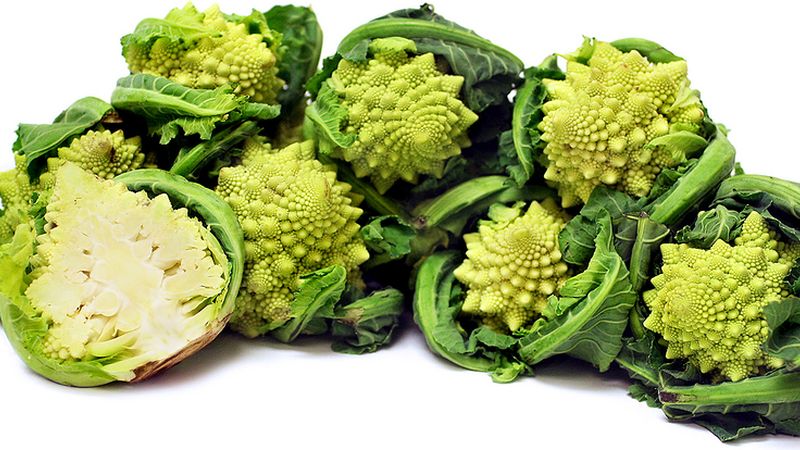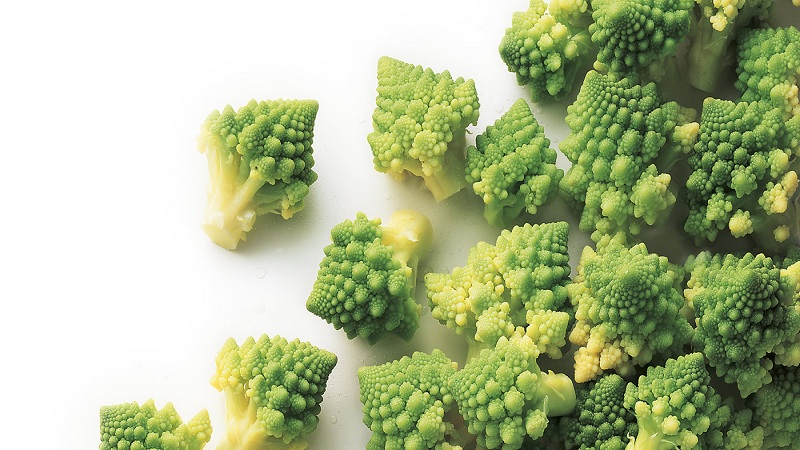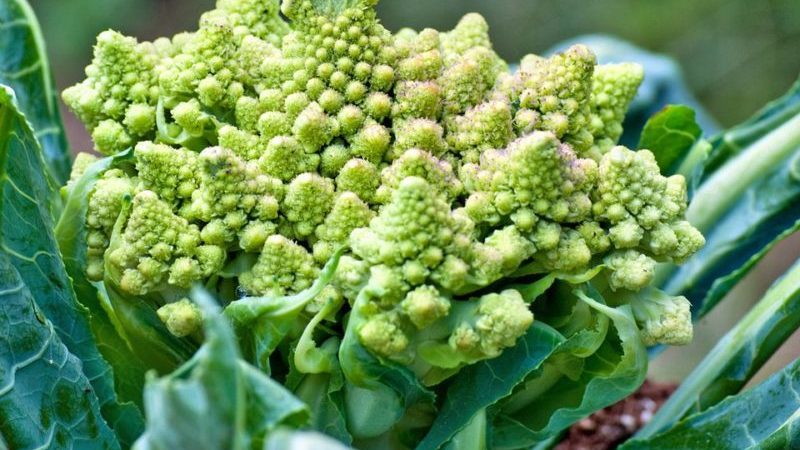Why is Romanesco cabbage useful, what it looks like in the photo, is it difficult to grow it and how to cook it
Romanov, Roman, Roman, coral cabbage - all these are the names of one culture. The structure of the pulp after cooking is surprisingly tender, with a pleasant nutty-creamy aftertaste. It is completely devoid of the bitterness inherent in broccoli.
In this article, we will talk about the theories of the origin of Romanesco cabbage, the benefits and harms to the human body, the features of its cultivation and methods of preparation.
The content of the article
What is Romanesco cabbage

Biologists have not yet come to a consensus about the origin of the Romanesco cabbage. The theory they proposed about the relationship with cauliflower and broccoli has not been confirmed.
Mathematicians are also involved in the study of the origin of culture. They put forward the theory that culture appeared in the 90s. XX century. Spiral inflorescences obey logarithmic equations, and breeders participated in the creation of cabbage together with 3D designers.
The first and second theories are being smashed to smithereens by historians who claim that the Etruscans knew about Romanesco. It was they who brought the plant to Tuscany. Other researchers believe that cabbage appeared in the 16th century, and gained fame at the beginning of the 20th century.
The name itself testifies to the Italian origin of the culture - romanesco means "Roman" in Italian. There are also other names - Romano, Romanov, Roman, coral cabbage.
Description and characteristics
Romanesco belongs to the Cruciferous family, the Cabbage genus and the Cabbage species. Latin name - Brassica oleracea L. var. botrytis L.
The cabbage shape resembles pyramids or shells. The fractal pattern is mesmerizing - pale green flowers are folded into regular-shaped figures and lined up in strict spirals. The inflorescences are densely packed and bordered by dark green leaves.
Everyone who has tasted romenesco describes its taste as delicate, delicious, sweetish, nutty, without bitterness and strong aroma. The stems are softer than cauliflower and broccoli. The mass rarely exceeds 0.5 kg.
In the photo - Romanesco cabbage.

Benefit and harm
Romanesco benefits:
- strengthening nails, hair, bones and teeth;
- improving skin condition;
- increasing stress resistance and body defenses;
- reducing the risk of SARS and cardiovascular diseases;
- strengthening of blood vessels;
- improved blood circulation;
- normalization of cholesterol levels;
- help in the treatment of allergies;
- accelerating the healing of wounds and cuts.
The product is contraindicated in case of individual intolerance. Excessive consumption of raw cabbage causes bloating and diarrhea.
The best varieties and hybrids
In the State Register of the Russian Federation, Romanesco cabbage was placed in the section "Cauliflower Varieties", since the biological nature of the culture is still unclear.
The table shows the characteristics of the most famous varieties and hybrids.
| Name | Ripening period | Head description | Productivity kg / m² | Sustainability |
| Veronica F1 | Mid-season hybrid | Triangular shape. The color is yellow-green. Weight - 1-2 kg | 4,5 | To fusarium and flowering |
| Emerald goblet | Mid-early variety | Triangular shape. Green colour. Weight - 500 g | 2,3 | To fusarium and flowering |
| Pearl | Medium late grade | Triangular shape. Green colour. Weight - 800 g | 2,7 | To fusarium |
| Puntoverde F1 | Mid-season hybrid | The heads are not covered with leaves. The color is pale green. Weight - 1.5 kg | 3,2 | To fusarium and flowering |
Growing Romanesco cabbage

The cultivation technique is complex in comparison with white cabbage or cauliflower. The plant is picky, and even minor errors in agricultural technology lead to failure. The optimum temperature for tying heads is + 18 ... + 20 ° С.
Romanesco is grown in seedlings. In the southern regions, direct sowing into the ground is allowed.
Growing conditions and soil requirements
When choosing a site, the rules of crop rotation are observed... Re-planting in the same place is performed after 4 years.
The best place to plant cabbage is after the potato. The soil after harvesting remains loose and nutritious. Romanesco is also planted after carrots, onions, cucumbers, tomatoes, beets, beans.
Cabbage does not grow well on heavy, clayey and nutrient-poor soils. The ideal option is neutral or slightly alkaline sandy loam, loose soil, fertilized with organic matter.
Acidic soil is not suitable for culture. Dolomite flour or slaked lime is used for deoxidation - 400-500 g per 1 m². The best conditions for the growth of cabbage are created by black soil.
In autumn, the site is dug up and fertilized with mineral compounds with potassium and phosphorus, but without molybdenum and copper.
In spring, wood ash is introduced into the soil - 400 g per 1 m² - and 20 liters of manure or compost.
Sowing seeds for seedlings
For the formation of ovaries, ideal conditions are created in the spring. Seedlings are ready for planting at the age of 1.5-2 months... Sowing seeds for summer harvesting is performed in early April.
Romanesco seedlings are grown in a greenhouse or apartment. A nutrient substrate is preliminarily prepared - turf, river sand, humus and peat are mixed in equal proportions. Then, disinfection is carried out by calcining in the oven or heating with steam. A 1% potassium permanganate solution is also suitable for this purpose.
The substrate is laid out in individual containers - tall plastic glasses or peat pots. Before that, drainage is placed on the bottom.
The seeds do not need processing, since they pass it in production. The seeds are buried in the soil by 0.5-1 cm, one in each container. Pour 0.5 cm of soil on top, lightly press it with your hand and pour it with warm, settled water.
The containers are left at room temperature until the first shoots appear. Then the air temperature is reduced to + 8 ... + 10 ° С for 7 days. After the seedlings are placed in a room with a daytime temperature of + 16 ... + 18 ° C and a night temperature of + 10 ° C.
Important! Seedlings grown at high air temperatures do not set their heads.
Romanesco seedlings need sufficient lighting, so the container is placed on a sunny windowsill. The sprouts are moistened as the upper layer of the substrate dries.
Outdoor planting
The transfer of seedlings is carried out not earlier than the last days of April in regions with a temperate climate. In the south, planting work is performed in March - early April. Cabbage is not afraid of colds and frosts down to -5 ° C, but nevertheless, it is better to postpone the transplant until the onset of heat.
On the site, holes are marked, commensurate with peat or plastic containers, observing a gap of 0.5 m. 200 g of wood ash are added to each one, mixed with the ground and watered.
Seedlings are removed carefully, trying to keep an earthen ball, and placed in the hole. Cotyledon leaves are left above the soil surface. The beds are watered abundantly after planting.
Further care

Romanesco care rules contain several important aspects:
- Watering. The culture is demanding on the irrigation regime, but does not tolerate waterlogging of the soil. The bushes are watered under the root with warm, settled water. Watering is carried out regularly: at the beginning of growth - 2 times a week, then - weekly. In rainy weather, the amount of watering is reduced to a minimum, in hot weather it is increased. Water consumption per 1 m² - 10 liters at the beginning of growth. As the cabbage grows, its quantity is doubled.
- Loosening. The procedure is carried out after each watering and is combined with weeding.
- Hilling. The regular hilling of the bushes accelerates the growth of lateral roots.It is recommended to add ash to the roots as a top dressing.
- Top dressing. During the growth period, the cabbage is fed three times. The best fertilizer is infusion of mullein (1:10) or bird droppings (1:15). The first feeding is performed 15 days after planting. Consumption per plant - 0.5 l. After 10 days, the dose is doubled. After 14 days, 15 g of superphosphate, 20 g of "Azofoski", 2 g of ammonium molybdate and boric acid are mixed into the infusion. With a deficiency of molybdenum, the heads coarse and become faded. Boron accelerates growth and protects against disease.
- Lighting. The plant is demanding on sunlight: it grows poorly in the shade, but under the scorching sun, the heads inhibit development and darken. After the formation of heads the size of a chicken egg, they are darkened by the broken upper leaves.
Harvesting
Harvesting is carried out before the heads begin to disintegrate - at this time, the content of vitamins and microelements in them decreases, the pulp becomes tough. The heads are cut off with a sharp knife with stems.
Cooking recipes

Romanesco cabbage is used for cooking salads, soups, casseroles. The inflorescences are fried, steamed, marinated in vinegar. The product goes well with other vegetables, mushrooms, creamy sauces and hard cheese.
Salad with prosciutto and sun-dried tomatoes
An interesting salad with a spicy lemon-mustard dressing will replace a full dinner or lunch.
Ingredients:
- Romanesco - 500 g;
- Whole grain bread - 2 slices
- parsley, green onions - to taste;
- sun-dried tomatoes - 5 pcs.;
- prosciutto or smoked ham - 100 g.
For the sauce:
- lemon - 1 pc.;
- mustard - 1 tsp;
- cane sugar - ½ tsp;
- olive oil - 3 tbsp l .;
- salt, pepper - to taste.
Preparation:
- In a bowl, mix lemon juice, mustard, sugar, salt, pepper. Add oil and whisk until sauce turns white.
- Rinse Romanesco under running water and disassemble into inflorescences. Boil 0.5 liters of water in a small saucepan, salt and blanch the cabbage in it for 5 minutes. Then discard the inflorescences in a colander, let the water drain.
- Wash the parsley and onion, dry on a waffle towel, finely chop.
- Cut ham (prosciutto) and tomatoes into strips.
- Cut the bread into cubes and fry in olive oil until crisp.
- Add all the ingredients to a salad bowl, stir and pour over the lemon mustard sauce. Garnish with parsley and serve.

Baked with mushrooms in a creamy sauce
This tasty and satisfying dish is a great alternative to cereal and pasta side dishes. The casserole is good hot and cold.
Ingredients:
- Romano cabbage - 500 g;
- champignons - 300 g;
- hard cheese - 170 g;
- eggs - 5 pcs.;
- onions - 1 pc .;
- cream 10% - 150 ml;
- dill, green onions - to taste;
- salt, black pepper, nutmeg - to taste;
- olive oil - 3 tbsp l.
Preparation:
- Rinse the cabbage with running water and disassemble it into inflorescences.
- Blanch in salted water for 8-10 minutes and transfer to a bowl of ice.
- Rinse the champignons and pat dry on a paper or waffle towel. Then cut into 4 parts and fry in a hot skillet until golden brown, season with salt and pepper to taste.
- Fry diced onions separately from the mushrooms.
- Layer the cabbage, onions and mushrooms in a ceramic dish.
- Beat eggs with salt, pour in cream, add a pinch of nutmeg and black pepper. Whisk the sauce until smooth and pour over the vegetables.
- Grate the cheese on a coarse grater and spread over the filling.
- Place the dish in an oven preheated to + 180 ° C and bake for 30-40 minutes.
Fried in batter

This recipe is another variation of cabbage in batter, but instead of cauliflower, Romanesco is used.
Ingredients:
- roman cabbage - 500-700 g;
- eggs - 2-3 pcs.;
- wheat or rice flour - 150 g;
- refined vegetable oil - 250 ml;
- salt, pepper - to taste.
For the sauce:
- sour cream 20% - 150 ml;
- garlic - 2-3 cloves;
- juice of half a lemon.
Preparation:
- Rinse the cabbage with running water and disassemble it into inflorescences.
- Blanch in salted water for 3-4 minutes and transfer to ice water.
- Beat eggs with salt. Gradually add flour and stir until smooth so that there are no lumps. It is convenient to do this with a spiral whisk.
- Pour oil into a deep skillet or saucepan and heat. Drop a little batter into it - when it starts bubbling, you can fry the cabbage.
- Dip pieces of Romanesco in batter and dip in hot oil. Fry until golden brown and place on a paper towel with a slotted spoon to remove excess grease.
- Prepare the sauce: mix sour cream with chopped garlic and lemon juice, pepper.
- Serve warm or chilled as desired.
Preparation for the winter
After harvesting, Romanesco cabbage is not stored for a long time and withers quickly, so they try to use it immediately or prepare it for the winter.
To preserve the full range of vitamins, cabbage is frozen. Heads of cabbage are sorted into inflorescences, washed, dried on a waffle or paper towel and packaged in tight plastic bags for freezing.
Romanesco cabbage can be canned in the same way as cauliflower, Brussels sprouts and broccoli. We suggest taking note of a simple pickled cabbage recipe. The appetizer turns out to be moderately spicy, slightly spicy, with a pleasant sourness.
Ingredients:
- Romanesco - 0.5 kg;

- carrots - 1 pc.;
- bell pepper - 2 pcs.;
- hot pepper - 1 pc.;
- black pepper and sweet peas - ½ tsp each;
- bay leaf to taste.
Marinade:
- water - 1 l;
- salt - 25 g;
- sugar - 50 g;
- dry parsley, oregano - to taste;
- vinegar 9% - 50 ml;
- vegetable oil - 50 ml.
Preparation:
- Prepare the marinade. Dissolve salt and sugar in boiling water, add spices, vinegar and oil, pour in at the end, boil for 10 minutes and turn off.
- Rinse Romanesco and disassemble into inflorescences. Try to keep the tops.
- Peel and cut the carrots into rings or strips.
- Cut the bell pepper into cubes or strips, finely chop the hot pepper together with the seeds.
- Pour the hot liquid over the vegetables, cover with tin lids on top and pasteurize for 10 minutes.
- Cap and turn over.
If you want to preserve the hardness of the cabbage, exclude the pasteurization step and immediately roll up the jars with lids.
It is interesting:
We keep the workpieces for a long time: is it possible to freeze sauerkraut.
A step-by-step guide on how to grow broccoli at home correctly.
Conclusion
Fractal cabbage, or romanesco, attracts attention with its unusual appearance and delicate green color. Inflorescences in the form of pyramids repeat the same pattern of cabbage - a fractal. The palatability is far superior to broccoli and cauliflower. There is no bitterness in the pulp, it is tender, nutty, sweetish.
Cultural agrotechnology requires a special approach. It is important to pay due attention to growing strong seedlings and to ensure sufficient watering, loosening the soil, hilling heads and applying additional fertilizing after transferring the seedlings to the ground.